#Object Classification
Explore tagged Tumblr posts
Text
We all know about the fuss around Pluto, how many decry its "demotion" to a dwarf planet, and how it's still an honorary planet in the hearts of many, and I totally get it, but I don't think any of you out there are taking it far enough.
What about the rest of the so-called "dwarf" planets, huh? where's their justice? what about Ceres? Haumea? Makemake? Eris? fucking Quaoar?! why have just eight planets when you can have 18?! Why only invite Pluto to the party if you're already gonna expand the guest's list?!
you know what should be "demoted"? fucking Phobos and Deimos, the two "moons" of Mars. these two motherfuckers are proof that the barrier-to-entry for moons is too low. they're barely visible, they don't effect mars in any meaningful way, they aren't even round since they aren't big enough to round themselves under their own gravity, and one of them isn't even in a stable orbit of Mars! Phobos is gonna get ripped apart by mars' gravity in just a few dozen million years!
the concept of a "Dwarf Moon" is too good for them. they should be called, like, sateloids or something. Lunoids at most. fuck em
#all of this is a joke btw#I know why Dwarf Planets are defined separately from the rest of the solar system#but tbf we as a society are sleeping on them hard#if Pluto was discovered after the concept of a dwarf planet was defined#most people wouldn't even know it existed#which is a shame because it's a fucking Baller!#you see those close up images we got?!#That Data About It?!#Fucking Sick!#cool and interesting as fuck!#but nobody'd care enough to know if we'd found it after coming up the idea of Dwarf Planets#imagine all the cool & interesting shit out in the Kuiper that'd be common knowledge#if they got the same attention pluto did for being 'The Ninth Planet'!!!!!#also fuck phobos and Deimos#we gotta come up with subcategories for moons fr#bc as it stands right now#a second earth orbiting jupiter#and a mcdonald's-sized boulder orbiting mercury shaped roughly llke mitt romney's dog#would be the same type of celestial object under our classifications#and I feel like there are some SIGNIFICANT DIFFERENCES THERE#like the only thing they'd have in common is orbiting a planet the way a planet orbits a star
22 notes
·
View notes
Text
Villain/#1 henchman is the second couple in this romantic drama. Their romance is so extra that it would eclipse the main couple were the main couple any less extra than their tiny but fearless little gothic heroine and her pet hundred-year-old, moral OCD-afflicted vampire selves.
#Snowfall#cdrama#the third couple is Mi Taitai and her hunky bodyguard and coming a distant fourth is Dr Situ and Villain Stalker Young Miss#no I’m not taking feedback on these classifications they are clearly objectively correct
11 notes
·
View notes
Text


Polyphemus Discovers Acis and Galatea Vase, c. 1925/30 Nicolas Constantin Platon-Argyaridès (1888-1968)
#artist: nicolas constantin platon-argyaridès#era: 20th century#medium: glass#medium: mold-blown glass#medium: enamel and gold on glass#medium: enamels and gold#genre: vase#genre: object#genre: history#movement: art deco#nationality: french#notable: revisit movement classification
2 notes
·
View notes
Text
my three separate playlists for punk, hardcore, and post-hardcore make me feel funny cuz philosophically i don't think those distinctions are delineated (or even real) enough to function as discrete separate categories but on the other hand it's a different vibe when i want to listen to thursday versus the hope conspiracy versus, like, crass
#i have imaginary conversations defending these three playlists and their contents too often 😅#it's much more of my personal intuitive vibe checking than any objective genre classification#like why is one step closer on hardcore not post? vibes dude. vibes#az rambles
2 notes
·
View notes
Text
Anyway, the deal here is that if you cut that One Old Thing (it was Fear? Or was a being that was trying to feed from something that all living beings feel because love and other things can be different from species to species, but fear is more common) into little and more little pieces, maybe you could transmute it into something handier, more then a book or a person. Purify it into something without inclination, without human contamination. A cold and scientific study of its body, its components, and how to purify and forge them.
#tmagp#tmagp thoughts#tmagp spoilers#its the alchemic shit that makes me wonder#this is about objects and classification#is about forgetting what you know about a being#that was extra dimensional and far more complex#then what the archives and the avatars thought#and maybe that being was feeding with an energy that was easy to found everywhere#but now it has a direct intention of consuming people#the victims didnt felt fear they where digested and incorporated#we have ink and wood and flesh and blood#its all about the material world
2 notes
·
View notes
Text
Four years of fucking grammar and I cannot work the hell out what the fuck "von jedem" is in the sentence "Mein Garten wird von jedem bewundert."
#Dativobjekt??? Dativobjekt.#Like girl a verb cannot simply evolve a hankering for a präp object by switching genus verbi alone#also screaming at the book to give me the adverbial classifications. begging on my HANDS AND KNEES#beablabbers#edit: WAIT THE DATIV IS NOT GOVERNED BY THE VERB IT IS GOVERNED BY THE PREPOSITION#SHAKES VON JEDEM LIKE WHAT ARE YOUUUUUUU
3 notes
·
View notes
Text
#i mean i personally never liked ng's writing that much BUT#this is a very important point in the general sense#bc for instance i love tolstoy's writing and he was also an absolutely horrible person from what i know#separating the art from the artist#food for thought#gaimangate#but i do have a problem with this person in the screenshots implying that#if you've never liked ng's writing and openly say so now that means#that you're a historical revisionist and a coward and denying that it's 'objectively good'#for the last time when are we going to fucking learn this?#NOTHING IS OBJECTIVELY GOOD!#if you like gaiman's work or tolstoy's work or anything else: that is your SUBJECTIVE taste#that's the beauty of art as a concept: there's nothing objective about it#only the eternal mysteries of taste and preference <- tags from cosmogyros



#As someone who never liked neil gaiman and never made a secret of that#It doesn't feel appropriate to go into my perspective now because I'm heavily aware that this is not about me#But I do feel that the classification of some art as “objectively good” can also have negative effects
48K notes
·
View notes
Text
the Magnus Institute kind of the AU SCP foundation if u think about it
#av speaks#tma#they have artifact storage#where all the scary ass anomalous objects are#and they have esoteric classifications for them#and are opaque as fuck about the level of danger things project#its not directly analogous but -gestures-
0 notes
Text
tag dump.📍
#tag dump.#📍[ AGENT IDENTIFIED : TROY. ] ╱ visage.#📍[ BODY SCAN IN PROGRESS. ] ╱ physique.#📍[ BEHAVIOUR PATTERN DETECTED. ] ╱ ch. study.#📍[ OBJECT ANALYSED. NO RISK DETECTED. ] ╱ aesthetics.#📍[ DATABASE SCAN COMPLETED. FILE FOUND. ] ╱ memes.#📍[ CRITICALLY FAST HEART RATE DETECTED. ] ╱ desires.#📍[ VALIDATION COMPLETED. COVER APPROVED. ] ╱ wardrobe.#📍[ OPENING CLASSIFIED DOCUMENT. ] ╱ headcanons.#📍[ ACCESS GRANTED. ] ╱ answered asks.#📍[ MISSION APPROVED. ] ╱ in character.#📍[ POTENTIAL THREAT IDENTIFIED. ] ╱ promo.#📍[ IDENTITY CONFIRMED. ] ╱ self promo.#📍[ SECURITY CLASSIFICATION: TOP SECRET. ] ╱ psa.#📍[ CLASSIFIED INFORMATION. ] ╱ ooc.
1 note
·
View note
Text
#Object Detection#Computer Vision#Object detection in computer vision#object detection and image classification#Image Preprocessing#Feature Extraction#Bounding Box Regression
0 notes
Text
Guide to Image Classification & Object Detection
Computer vision, a driving force behind global AI development, has revolutionized various industries with its expanding range of tasks. From self-driving cars to medical image analysis and virtual reality, its capabilities seem endless. In this article, we'll explore two fundamental tasks in computer vision: image classification and object detection. Although often misunderstood, these tasks serve distinct purposes and are crucial to numerous AI applications.

The Magic of Computer Vision:
Enabling computers to "see" and understand images is a remarkable technological achievement. At the heart of this progress are image classification and object detection, which form the backbone of many AI applications, including gesture recognition and traffic sign detection.
Understanding the Nuances:
As we delve into the differences between image classification and object detection, we'll uncover their crucial roles in training robust models for enhanced machine vision. By grasping the nuances of these tasks, we can unlock the full potential of computer vision and drive innovation in AI development.
Key Factors to Consider:
Humans possess a unique ability to identify objects even in challenging situations, such as low lighting or various poses. In the realm of artificial intelligence, we strive to replicate this human accuracy in recognizing objects within images and videos.
Object detection and image classification are fundamental tasks in computer vision. With the right resources, computers can be effectively trained to excel at both object detection and classification. To better understand the differences between these tasks, let's discuss each one separately.
Image Classification:
Image classification involves identifying and categorizing the entire image based on the dominant object or feature present. For example, when given an image of a cat, an image classification model will categorize it as a "cat." Assigning a single label to an image from predefined categories is a straightforward task.
Key factors to consider in image classification:
Accuracy: Ensuring the model correctly identifies the main object in the image.
Speed: Fast classification is essential for real-time applications.
Dataset Quality: A diverse and high-quality dataset is crucial for training accurate models.
Object Detection:
Object detection, on the other hand, involves identifying and locating multiple objects within an image. This task is more complex as it requires the model to not only recognize various objects but also pinpoint their exact positions within the image using bounding boxes. For instance, in a street scene image, an object detection model can identify cars, pedestrians, traffic signs, and more, along with their respective locations.
Key factors to consider in object detection:
Precision: Accurate localization of multiple objects in an image.
Complexity: Handling various objects with different shapes, sizes, and orientations.
Performance: Balancing detection accuracy with computational efficiency, especially for real-time processing.
Differences Between Image Classification & Object Detection:
While image classification provides a simple and efficient way to categorize images, it is limited to identifying a single object per image. Object detection, however, offers a more comprehensive solution by identifying and localizing multiple objects within the same image, making it ideal for applications like autonomous driving, security surveillance, and medical imaging.

Similarities Between Image Classification & Object Detection:
Certainly! Here's the content presented in a table format highlighting the similarities between image classification and object detection:
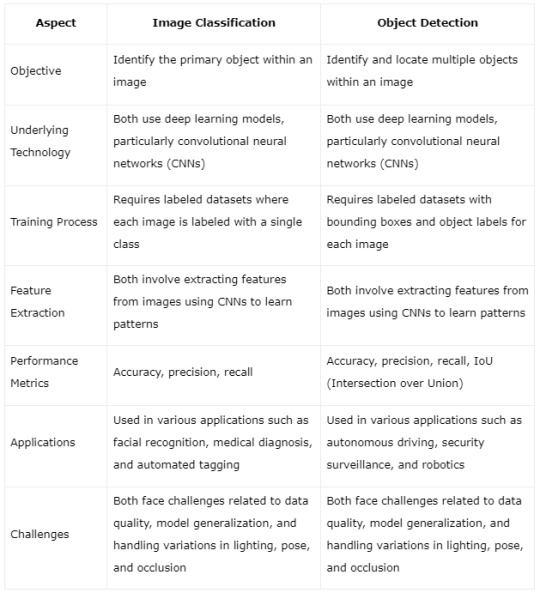
By presenting the similarities in a tabular format, it's easier to grasp how both image classification and object detection share common technologies, challenges, and methodologies, despite their different objectives in the field of computer vision.
Practical Guide to Distinguishing Between Image Classification and Object Detection:
Building upon our prior discussion of image classification vs. object detection, let's delve into their practical significance and offer a comprehensive approach to solidify your basic knowledge about these fundamental computer vision techniques.
Image Classification:
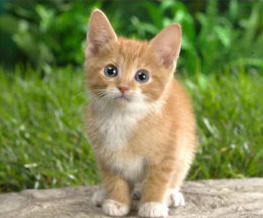
Image classification involves assigning a predefined category to a visual data piece. Using a labeled dataset, an ML model is trained to predict the label for new images.
Single Label Classification: Assigns a single class label to data, like categorizing an object as a bird or a plane.
Multi-Label Classification: Assigns two or more class labels to data, useful for identifying multiple attributes within an image, such as tree species, animal types, and terrain in ecological research.
Practical Applications:
Digital asset management
AI content moderation
Product categorization in e-commerce
Object Detection:

Object detection has seen significant advancements, enabling real-time implementations on resource-constrained devices. It locates and identifies multiple objects within an image.
Future Research Focus:
Lightweight detection for edge devices
End-to-end pipelines for efficiency
Small object detection for population counting
3D object detection for autonomous driving
Video detection with improved spatial-temporal correlation
Cross-modality detection for accuracy enhancement
Open-world detection for unknown objects detection
Advanced Scenarios:
Combining classification and object detection models enhances subclassification based on attributes and enables more accurate identification of objects.
Additionally, services for data collection, preprocessing, scaling, monitoring, security, and efficient cloud deployment enhance both image classification and object detection capabilities.
Understanding these nuances helps in choosing the right approach for your computer vision tasks and maximizing the potential of AI solutions.
Summary
In summary, both object detection and image classification play crucial roles in computer vision. Understanding their distinctions and core elements allows us to harness these technologies effectively. At TagX, we excel in providing top-notch services for object detection, enhancing AI solutions to achieve human-like precision in identifying objects in images and videos.
Visit Us, www.tagxdata.com
Original Source, www.tagxdata.com/guide-to-image-classification-and-object-detection
0 notes
Text
i find myself slipping into a buddhistic obsession with suffering ... its so difficult of late to justify the very universe as one whose fundamentally amoral laws tacitly permit such endless pain and alienation as this, even indirectly, through their all-permissive silence
#though i suppose for all the world classification of “the universe” as an independent object of study#is the gnostic move and distinctly contrary to most buddhist metaphysical analyses. i'm just tired#i wish there was a way to transcend natural law . yet the potential cost of such a method......
0 notes
Text
Image Classification vs Object Detection
Image classification, object detection, object localization — all of these may be a tangled mess in your mind, and that's completely fine if you are new to these concepts. In reality, they are essential components of computer vision and image annotation, each with its own distinct nuances. Let's untangle the intricacies right away.We've already established that image classification refers to assigning a specific label to the entire image. On the other hand, object localization goes beyond classification and focuses on precisely identifying and localizing the main object or regions of interest in an image. By drawing bounding boxes around these objects, object localization provides detailed spatial information, allowing for more specific analysis.
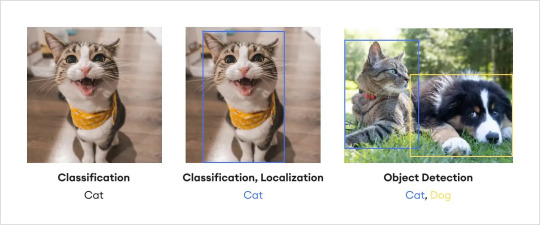
Object detection on the other hand is the method of locating items within and image assigning labels to them, as opposed to image classification, which assigns a label to the entire picture. As the name implies, object detection recognizes the target items inside an image, labels them, and specifies their position. One of the most prominent tools to perform object detection is the “bounding box” which is used to indicate where a particular object is located on an image and what the label of that object is. Essentially, object detection combines image classification and object localization.
1 note
·
View note
Text
Revisiting 123 TMAGP (CAT#) Theory
Spoilers for up to episode 16 of TMAGP.
It's been a couple of weeks since I first put together this theory for myself and I wanted to add on some thoughts. Spoilers below the cut!
Here is my updated spreadsheet:
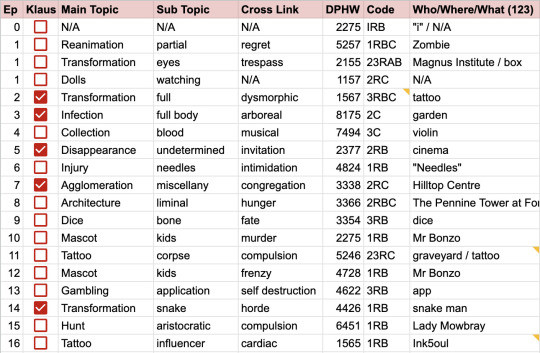
I still feel like 1 / 2 / 3 definitely act as a categorical grouping which are not mutually exclusive, with the general theme of who / where / what respectively. But there is a bit of an inconsistency in which statements receive what categorical assignment.
To clarify categories as I interpret them:
"Who" in my mind defines an avatar, or a person who somehow has super natural abilities that are innate (and not a result of a "where" or a "what").
"Where" defines a location that either causes paranormal events, or attributes supernatural qualities to the people inhabiting that space (Pennine Tower, the garden in Infection). Looking back, this one is the one I'm a bit skeptical of now. Namely because there are two statements that I feel like still don't quite make much sense based on my personal interpretation of what a "where" is. I'll get into that in a moment.
"What" is a thing (physical, or something that you can interact with) that has supernatural traits. Saw somebody say that tattoos are hardly a thing and I disagree. It's on your skin. You can touch it, interact with it, right? Same thing with apps. I digress.
Now to talk about the inconsistencies.
Ink5oul: Episodes I'm referencing are 2, 11, and 16.
For a while, I had a theory that Ink was not an avatar and instead had a tattoo machine that was supernatural (maybe Oscar Jarrett, referenced by Ink in episode 11, has a tattoo machine that they now use or something). This would explain why they could be referenced in (and sometimes the direct cause of the events in the episode) without being considered a paranormal being. We also need to consider how their tattoos include alchemical symbols, which are clearly important in this universe. This aligns with the classifications we saw in relevant episodes.
Then we got episode 16, and now I'm a bit confused to be honest lol, because it's classified as a 1. Based on my theory that the tattoos were supernatural and were therefore classified as "3s," I'm a bit mystified by this one. So here are some explanations I have thought of (though I am sure there are other reasons):
Ink only "triggered" the classification because they were physically present. When comparing it to episode 2, they were not physically present when Daria started to change her appearance, and in episode 11, they played no (supernatural) role in the events that occurred.
Ink has become an actual avatar since the events that transpired in episode 2. There is enough of a time frame where this could have happened, and the timeline kind of makes sense? Episode 11, they obsess over the ocean tattoo and maybe they discover something about it — with alchemical symbols, a tool, I don't know — that causes them to begin their practice. Episode 2 they give a tattoo to Daria, and they're still not quite an avatar, but the tattoos sure as hell are supernatural (because of the alchemical symbols? an evil magic tattoo machine? i dunno). At this point, they would still be new at it, and this makes sense because Daria says, "They’re pretty popular these days," which implies that it's a recent thing. And now, by episode 16, they themself are an avatar.
Regardless, assuming ink is an avatar (and they don't carry a supernatural item such as the bone dice and viol-ence), I would still expect this episode to be classified as a 13 based on previous statements to account for the tattoo.
Inconsistent 2s: Episodes I'm referencing are 7 and 11 (again lol)
There are two statements that are classified with CAT#2 that I am uncertain about. I'll start with episode 7 — Hilltop Center.
I'll be honest, I definitely saw the name Hilltop and immediately made connections with TMA, and thought "it must be relevant." And when I first started to see the commonalities between statements and the three classifications, it technically fit right in – it's a place, isn't it, and a canonically significant one at that. But I feel like I may have gotten ahead of myself with the excitement from the reference. This is a different reality from TMA. The Institute is in Manchester now, why would the same qualities exist in Hilltop in this universe?
Now, while it is possible that Hilltop caused the events that occurred in episode 7, when you think about the content of the episode itself, it has more to do with "who" rather than "where." It starts with one person who is strange and uncanny who ends up bringing more and more of their "friends" who want to "help." This "person" seemed to have originated outside of this place. And the statement giver (aside from being, yknow, traumatised probably), is not affected / changed by any "supernatural" quality of the Center. So why is this episode classified as CAT#2??? I don't know.
For episode 11, I'm a little uncertain to how place is immediately relevant. 3 makes total sense — it's a weird creepy tattoo. But I feel like 2 is not immediately clear as to why it is important in this episode, but wait, okay now that I'm writing this sentence, episode 15 is started to give us a bit more to work with actually–
Okay NEVERMIND. New theory. Episode 11 being classified as CAT#23 makes total sense. The cemetery is located in Padstow, and is a place where lots of sailors were buried. In episode 15, Luke orders a beer called "Doom Bar," also from Padstow, named after the Doom Bar sandbank. On their site they wrote: "The sandbank is revered as a formidable nautical challenge that should be approached with respect and navigated with skill." So I guess, what I'm trying to say, is maybe this sandbank, this part of the coast, is supernatural in nature. But it's just not immediately clear why it's classified in that way and why it's included in this episode's classification number — we just always need more information.
Snakes: Episode I'm referencing is 14
Is the guy that vomits the snakes everywhere an avatar? Like, I'm not really sure. And the statement giver too, says she feels her throat get all weird. I guess maybe it's an infection? But does that count as a who or a what? I'm not sure.
Theories:
Finally, this brings me to the issue of how the hell these statements are categorized in the first place. Because we have inconsistencies. How can Transformation (full) -/- dysmorphic result in a CAT#3 and Transformation (snakes) -/- horde result in a CAT#1? "Dysmorphic" and "horde" are the cross reference so I feel like we can rule those out. "Full" and "snakes" are the subsections of transformation. So how do those two words result in different CAT#s?
So my current theory which is definitely a cop-out, hand wavey one because I have NO IDEA is that I feel like the tables and binder and cross reference stuff must, in some way, be supernatural because there's no way somebody created a system this...well, flexible? It would need to be constantly updating to accommodate new language (such as "influencer" since that is of the Internet Instagram Era), and seeing as FR3-D1 is an old ass system and the two seem closely related, I feel like the classification system can't be Normal.
Conclusion: I think the 1 / 2 / 3 - who / where / what (or any variation of it) has a lot of merit, I just think that, like all things in Protocol, there is more nuance than we can see at the moment. We just need to know more.
123 TMAGP (CAT#) Theory
So I haven't seen my theory about how the CAT# works on here so I'm not sure if anybody else has noticed this but I figured I should share! I'm pretty sure that whether a statement is labelled 1-2-3 defines what kind of content is paranormal in the episode.
EDIT: Spoilers below the cut
Here's my spreadsheet ordered by CAT# ("code" in the last column):
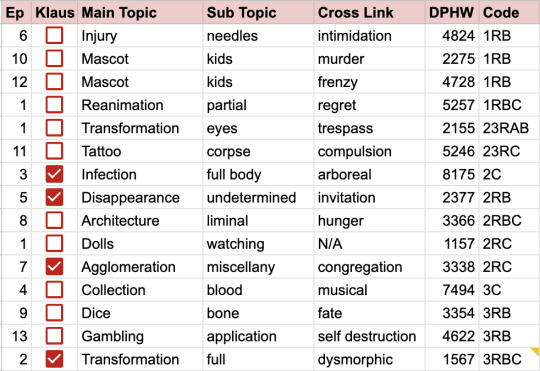
I noticed that when I put the statements in order of "code", the main focus of each episode had something in common. Looking at statements coded "1" I noticed that they all had to do with a person. Episode 6 -- Needles, Episode 10 and 12 -- Bonzo, and episode 1 "reanimation" was the zombie guy. Okay, so statements labelled with a 1 seem to have something to do with people.
Next set, the 2s. Episode 5 -- the cinema. Episode 7 -- Hilltop Centre. Episode 8 -- Pennine Tower. These episodes all have to do with place that are paranormal by nature.
Finally, the 3s: episode 2 -- a tattoo. Episode 4 -- the slaughter violin. Episode 9 -- bone dice. Episode 13 -- the app. These episodes all have an "artefact" of some kind, whether that be a physical object or something literally tattooed into someone's body, that doesn't seem to matter. It's some kind of thing or object.
Of course, as we've noticed, CAT#s have appeared as 1 / 2 / 3, but also as groups of numbers, such as 23 in episodes 1 and 11, and on the Klaus spreadsheet as 12 and 13. This indicates that statements with multiple types of paranormal presences can have multiple IDs. In the case of episode 1 "transformation," the Magnus Institute is the paranormal place, and the box might be the object. In episode 11, the graveyard and the tattoo are the two major appearances.
Here's my spreadsheet with who / where / what
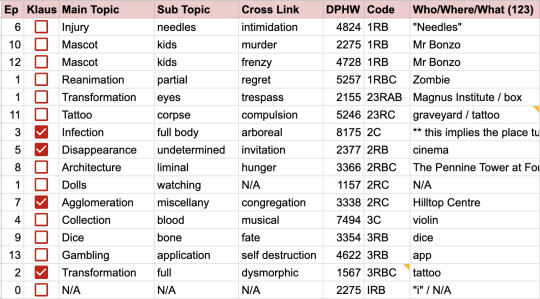
I just thought it was cool! And the episodes seem to align with my theory the majority of the time (the only one i'm mildy uncertain about is episode 3, because that implies that the reason the guy turned into a tree was because of the place but it's been a while since i listened to that episode so maybe it makes sense lol).
#the magnus protocol#the magnus protocol theory#tmagp#tmagp theory#cat number#i saw someone make a post that was disagreeing with certain aspects of the person place object theory#and they made a lot of valid points that had me rethinking the way i interpret this theory#but between what i read of their post and revisiting my own notes i feel like our problem is that we just dont know enough#we dont have enough information#the location classification in episode 11 didnt make much sense#but literally as i was writing this post#i realised that now that we know what we know in episode 15 with doom bar and whatnot it's starting to make sense in regards to episode 11#the more we learn the more we can see in hindsight#so there are probably some gaps in the cat number theories that we dont even KNOW about#but i think overall it has a lot of merit and works as a general classification of each episode#we might just need to rethink the words we use to describe 1 / 2 / 3#agh we need to know MORE#we need more info!!#also sorry for the long ass post#im done with school#i shouldnt be writing this many words#please feel free to reply with your thoughts and stuff
91 notes
·
View notes
Text
fucking HATE when someone has a good take but just like has to go and bring up something i'm well versed in and be incorrect about it. like. i'm not gonna be a dick and correct you esp if it's fairly inconsequential to ur argument, but like fuuuckkksaaauauagh can u just not bring up this thing if u don't know about it
#this is very largely about people being incorrect about medical stuff#and i don't mean like i think they're wrong about their own personal medical stuff i would fucking never#but like if someone is talking about anxiety and they're like#'actually u should do x thing bc the PNS innervated ur lungs and the SNS innervates the heart'☝️🤓#and it's like unfortunately ur just objectively wrong about that. and like#wrong in a way that lets me know you don't really know what it means#same thing w like being wrong abt drug classifications in a really insane way#and now drug classifications are actually largley fucking vague bullshit#but sooooooo annoying when someone's like well ofc i'm not gonna like x drug it's a depressant and gives me panic attacks'#like first of all. not a depressant (tho that's more subjective sure#but it's not a parasymathomimetic so i feel my point stands#and just domt attach ur argument abt it giving u panic attacks to it supposedly 'being a depressant' like those two DONT GO TOGETHER#wow that was a long rant okay bye#ugh not gonna re-type that but i meant to say 'wrong abt drug classifications in a really INNANE way' as in silly and inconsequential and#i KNOW i'm being pedantic and annoying i just need to get it out of my system way#also *parasympathomimetic#i cant type oh well
1 note
·
View note
Text
Backyard Worlds Volunteers Complete Ten Million Classifications in an Epic Search for New Objects Among the Nearest Stars
The Backyard Worlds: Planet 9 and Backyard Worlds: Cool Neighbors projects invite members of the public to search images from NASA’s Wide-Field Infrared Survey Explorer (WISE) mission to find new objects among the nearest stars. from NASA https://ift.tt/EOYqcuU
#NASA#space#Backyard Worlds Volunteers Complete Ten Million Classifications in an Epic Search for New Objects Among the Nearest Stars#Michael Gabrill
0 notes